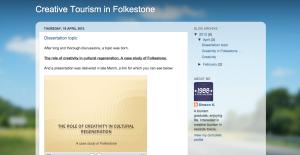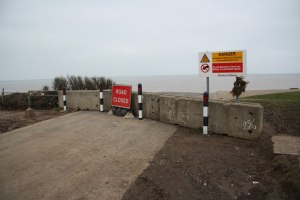One of our MA students has created this new blog for their final research project. I’ll be supervising this dissertation and I’m looking forward to working with Simeon on his investigation of the role of creativity in the regeneration of Folkestone – please do check it out and comment if you can!
Creative tourism in Folkestone
Posted in Uncategorized | Tags: cultural regeneration, folkestone
Regional approaches to seaside regeneration
This is a table showing contemporary regional approaches to seaside regeneration. Of course, the Regional Development Agencies are almost historical artifacts now, but this captures the current state of play. It will be very interesting to see how far (if at all) local authorities and LEPs deviate from these approaches.
Posted in Data, Governance, Policy, Updates | Tags: analysis, Governance, LEP, local enterprise partnerships, Policy, regeneration, regional, seaside
National regeneration programmes applied to Seaside Towns
This document is a table of national regeneration programmes that have been applied to Seaside Towns since the mid 1980s. The literature on this is quite sparse, so this is very much a work in progress. If you have details of programmes that I’ve missed, please let me know!
Posted in Data, Governance, historical, Policy, Updates | Tags: Governance, history, Policy, regeneration, seaside
The final countdown
After five years, hopefully I’m now coming to the end of this research. I’ll be on sabbatical from my post at the University of Greenwich for the next six months, while I finish off my fieldwork and put together the first draft of my thesis.
Over the next two months, I’ll mostly be found in and around the Creative Quarter in Folkestone. I’ll be carrying out fieldwork there through August and September. I’ll also be updating some of my earlier chapters and posting up some of my content on here – specifically some timelines of seaside regeneration and some policy review material. I’m hoping to amass a large amount of photographs in the coming weeks too and I’ll be putting together some posts like this previous one. In the next month or so, I’ll also update the seaside regeneration archive.
With the wind behind me, I should be able start posting up my findings on the social impact of culural regeneration in seaside towns from the end of this year. If you’d like to talk to me about this research, please do get in touch.
Posted in methods, Updates | Tags: cultural regeneration, folkestone, regeneration, seaside
Rediscovering cultural tourism: cultural regeneration in seaside towns
I’ve just had this article published in the Journal of Town and City Management, a large part of which is based on a case-study of Margate. The paper sets out the place of cultural regeneration in the national context of seaside regeneration in England.
The abstract is below. If you’d like to know more about this paper and don’t have access to read it online, please get in touch.
“British seaside towns have been subject to numerous attempts at regeneration and rebranding since the collapse of traditional seaside tourism began in the late 1970s. This paper reviews contemporary approaches to seaside regeneration and demonstrates that cultural regeneration strategies are becoming increasingly prevalent in this area. The validity of transferring city-based models of cultural development to these smaller urban areas is critiqued. The history of cultural investment in seaside towns is highlighted to show how current approaches to cultural regeneration, while presented as novel, are in fact a resumption of earlier strategies of cultural tourism development. This heritage of cultural development provides a resource for seaside cultural regeneration which may allow development of this type to avoid the negative social impacts often associated with cultural regeneration in cities.”
Posted in Governance, historical, Policy | Tags: history, Margate, Policy, regeneration, regional, seaside
Seaside towns and Local Enterprise Partnerships
Our paper on seaside towns and local enterprise partnerships has just been published in the proceedings of the 2010 ATHE conference. Click here to go to the ATHE website where you order a copy of the proceedings. The abstract is below:
Despite their huge popularity as holiday destinations, seaside towns have generally been under-researched. Existing research is limited to narrow historical perspectives and is often focused at a regional level. British seaside towns have suffered a significant decline but there is little attention given to how contemporary issues are likely to shape their futures. For this paper, a sample of British seaside towns that form part of the newly approved Local Enterprise Partnerships (LEPs) are analysed to identify how these new governance arrangements are likely to affect future development in these areas. Core-periphery theory (CPT) is used as a framework within which to analyse these arrangements and to identify potential problems and obstacles. Analysis reveals significant governance issues for seaside towns in terms of structural inequalities and relationships of dependency. The LEPs do not adequately recognise the peripheral nature of seaside towns and the special conditions needed for their development. There is a reliance on outdated growth models and there is a lack of innovation in their approach. From a CPT perspective, the new LEPs do not seem to provide a brighter future for the development of seaside towns.
Posted in conferences, Governance, Policy | Tags: Governance, LEP, local enterprise partnerships, Policy, regeneration
The final stages…..
Four years after starting this research, I’m finally embarking on its final stages. I should be taking a sabbatical from my work to finish writing this up from July and then hopefully submitting in December.
Apart from a few interviews, the final bit of work that I have to do is about capturing the perspectives of residents of the areas that have been subject to cultural regeneration in Whitstable, Folkestone and Margate. I’m planning to do this through a series of small, informal focus groups in each town.
If you live in or around Whitstable Harbour and Town Centre, Folkestone’s Creative Quarter or Margate’s Old Town and are interested in being involved in these focus groups please do let me know – leave a comment on here or contact me via the contact page.
I want to hold these groups to get a snapshot of local people’s views, and also to get an insight into the kind of debates that local people are having about the impacts of regeneration on their lives and their communities.
Hopefully I’ll be setting these focus groups up from the end of February and then into March. If you’d like to get involved, please do get in touch!
Posted in Data, focus groups, methods, Updates | Tags: cultural regeneration, focus groups, folkestone, Margate, regeneration, seaside, whitstable
Margate’s Old Town
This is a slideshow of pictures taken as I walked around Margate’s Old Town last week. There are clearly a greater range of activities taking place in this regenerating space than were observed in Folkestone in this previous post, and more people using the space, for a variety of reasons. The Old Town is a focus of creative activity in the town but, to a greater extent than in Folkestone’s Creative Quarter, it features a range of uses and is integrated into a broader residential and retail context.
Why choose the arts to regenerate a community?
This is the presentation that I gave at the ‘Cultural Journeys’ conference at University Centre Folkestone on 9th September. It is mainly images, but if you download it you can read my notes in the PowerPoint file that include references to some useful sources about cultural regeneration.
Posted in conferences | Tags: cultural regeneration, regeneration, seaside
A walk around Folkestone’s Creative Quarter
A slideshow of pictures, taken without any attempt to focus on particular uses of the space in the Creative Quarter in Folkestone, but solely to record the space as it would present itself to a visitor and to map the boundaries of the development.
Posted in Data | Tags: cultural regeneration, folkestone, regeneration, seaside




Comments